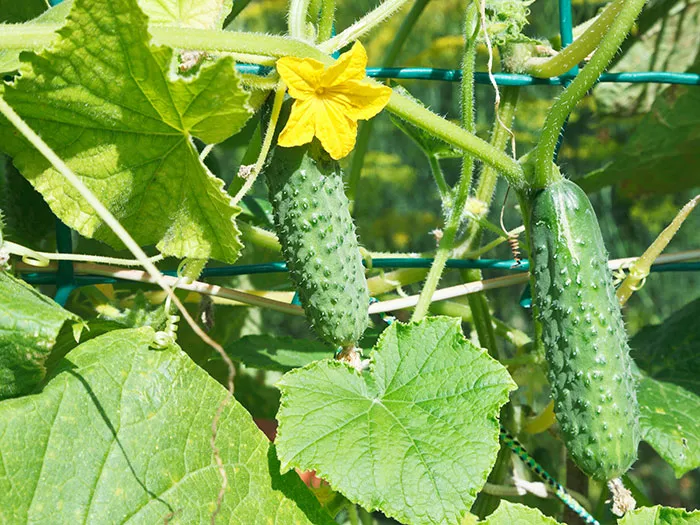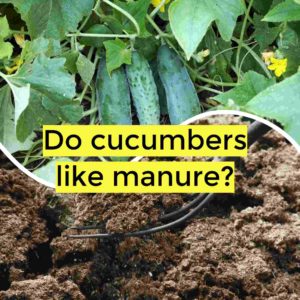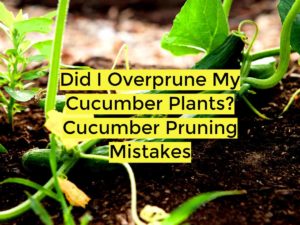Common Issues Faced Growing Cucumbers In Pots
Cucumbers are vulnerable to a wide variety of parasites and diseases. Also, they are difficult to transplant. Here are a few potential issues with the growing cucumbers in pots.
1. Angular leaf spot appears as lesions on cucumber leaves. The lesions turn into angular holes. This disease will spread rapidly through infected cucumber pots. But the most common cause of infection in container gardens is the use of contaminated seeds. The most effective strategy for evading this problem is to obtain your seeds from a reliable nursery.
2. The wide leaves of the cucumber plant, like the wide leaves of all cucurbit plants, are susceptible to the fungus known as powdery mildew, which produces a white, powdery residue to coat the foliage. You can reduce the risk of issues caused by this disease by encouraging the growth of vines in a vertical direction, where there is a greater circulation of air and less accumulation of moisture.
3. Bugs known as cucumber beetles are yellow and black and pose a threat to growing cucumbers for two reasons. The adults feed on the plant’s leaves, but the larvae consume the plant’s roots. Both stages of the insect eat the plant. When growing cucumbers in pots, the best way to protect the plants from these pests is to place the containers safely away from any ground gardens or other types of greenery.
Read: How Much Water Does A Cucumber Plant Need Per Day?
How to grow cucumbers in pots

Step 1: Install the support structures for the cucumbers that are developing in the pots in step one. The developing cucumbers in containers shouldn’t be harmed during or after germination. Thus, it is preferable to prepare things in advance. You can also position the trellis beneath the container.
Step 2: Add a layer of compost to the planting pot that is one inch thick, and make sure the soil is loose and pleasant to the depth of at least eight inches.
Step 3: In the pots, bury a cluster of 6–8 seeds about 1.5 inches deep. They won’t be able to expand and break the surface after germination if you cover them too much.
Step 4: Once the seedlings have two sets of leaves, choose two or three of the healthiest plants and pinch or cut the others off at the ground level.
Although it may be tempting, you should resist the urge to remove the extras and plant them somewhere else. The roots of the existing plants will be harmed if the seedlings are pulled out.
Step 5: Water the cucumbers as they grow frequently to ensure uniform soil moisture. Aim for irrigation every three to four days which is equivalent to an inch of rainfall. The plant will wilt if the soil is allowed to become too dry.
Step 6: As the cucumber vines develop, train them to climb the support. You can achieve this by assisting the vines in entwining around the support. You can carefully tie the plant in place with soft, clean cloth strips for vines that need assistance connecting to the support.
Step 7: As the vines get older, add more mulch to the soil to help them retain moisture.
Step 8: When growing cucumbers in pots, fertilize them every two to three weeks by applying a diluted liquid fertilizer to the root zone. A word of caution: overfeeding of the plants can result in abundant foliage but few blossoms and fruits.
12 Tips for Growing Cucumbers In Pots

1. Select the proper pot
When loaded with soil, ceramic containers are prone to become unmanageably heavy and difficult to move about. Because it is more difficult to manage the moisture that seeps out of them, cloth pots are not a good option for use inside the house even though they are less in weight.
No matter what material you go with, the container should have a depth of at least 16 inches, a width of at least one foot, and the capacity to store about 6 gallons of soil. This will ensure that there is ample room for the majority of cucumber kinds. Vining varieties, on the other hand, will do better in a larger and heavier container, particularly if you intend to train them to grow in a vertical orientation.
The use of plastic, ceramic or even linen pots are all viable options when it comes to growing cucumbers in pots. Before settling on the type of pot you’ll be using, you should first evaluate whether or not you intend to move the pots once they are full or whether or not you anticipate having to bring them inside (if you start them earlier in the spring or want to extend the season in the fall).
In addition to this, your container has to have sufficient drainage so that any extra moisture may escape whenever you water it.
2. Use fertile soil
A potting soil of superior quality will be beneficial to the growth of cucumbers in containers. This specialized soil is superior to conventional garden soil in its ability to both absorb and release moisture.
For the prolific fruit production that cucumbers are famous for, the plant requires a significant amount of various nutrients. As a result of this, it is of the utmost significance to develop a nutrient-dense starting soil for your seedlings. This is of considerably greater significance when growing cucumbers in containers.
When growing cucumbers, in particular, you will also want to incorporate a substantial amount of compost as well as some slow-release fertilizer into the soil. This will offer your young plants a sufficient amount of nutrients to get them off to a healthy start, as well as more nutrients as they start to produce fruit.
3. Prepare for cooler temperatures
You can shield your huge plants from an early cold snap that will be followed by warm weather by using a sheet or bringing smaller, shrub varieties of plants inside if you expect the cold weather to be followed by warm weather.
If you know that a severe freeze is coming and you still have fruits growing on the vine, harvest anything that is getting near to being ripe so that you don’t end up throwing it away. As soon as the temperatures begin to drop in the fall, the number of cucumbers that are produced will start to decrease. However, the plant will remain alive until the very first cold.
4. Find a sunny spot When Growing Cucumbers In Pots
Because the majority of cucumber types can tolerate high temperatures, a sunny wall that faces south is typically an effective location for growing them. However, you need also think about how easy it will be to obtain food and water in that area. Look for places that are illuminated by the sun for at least eight hours per day.
5. Plant your seeds in the ground directly.
It is common knowledge that cucumbers do not adapt well to being transplanted. Instead of purchasing seedlings, it is more cost-effective to purchase seeds and plant them directly into the pots you intend to use.
When you have finished preparing the soil and giving it plenty of water, you may begin planting your seeds.
Because cucumbers are warm-season plants, the soil in which they are planted must be at least 60 degrees Fahrenheit for them to germinate successfully, and they cannot survive temperatures below freezing.
In most climates, you should begin sowing seeds approximately two weeks following the last frost date. You also have the option of bringing your pots inside where you can start your seeds early and then transfer them outside once the weather is warmer.
For more detailed directions, refer to the back of the seed packet you purchased; but, in general, you should plant your cucumber seeds approximately 1 inch below the surface of the soil. Plant three seeds in each container, then remove all but the healthiest seedlings once the seedlings have reached a height of about two to three inches.
6. Water on a regular basis
You will only need to water the soil once every few days in order to maintain a moist environment for your seedlings while the weather is still on the cool side.
You will need to water the plants more frequently once they have reached their full size, and especially once they begin producing fruit that is heavy with moisture.
The trick is to prevent the dirt from becoming saturated while maintaining a consistent level of dampness that can be felt on the surface of the ground at all times. The bottom of your pot should have adequate drainage holes, or you may use a cloth pot that drains continuously for additional assistance with this. After the surface of the soil has become dry, it is time to water it once more. To find out more about watering cucumbers, click here.
7. Apply fertilizer according to the situation
If you put in the extra effort to amend the soil with fertilizer that releases over a period of time when you prepare it for planting, you will not have to fertilize the plants again until they begin to produce fruit or vegetables. Making a fertilizer tea out of grass clippings is an excellent and economical way to provide nutrients to your lawn or garden. In any other case, you can make use of a liquid fertilizer that has been diluted. In any scenario, you should apply the fertilizer once every three to four weeks all the way through the summer.
8. The selection of trellises

Also, think about the different trellis alternatives for each of the potential locations. Cucumbers that are grown on vines need a trellis that is rather tall and can be up to eight feet high, or they need a lot of room to spread out along the ground. On the other side, bushy cucumbers will only require a few feet of space in order for their leaves to spread out.
9. Supporting bush cucumbers using cages
It is best to get the trellis or cage ready for your seedlings well before they reach their full size.
You only need a tomato cage if you have bush varieties that you wish to train to grow vertically (so that you may reduce the amount of space needed and maximize the ventilation). After positioning the cage over the seedling, gently coax the climbing vines back inside the cage’s wires on a daily or weekly basis until they begin to climb.
10. A long support structure for growing vertical cucumbers
In order to support climbing kinds, you will need to construct a lengthy trellis out of posts and nets, threads, or mesh. In addition to chicken wire, pea netting is another excellent choice. You can also use individual strings to create a trellis for your plants by training vines to climb them. Just make sure to steer clear of mesh that has openings that are any larger than a half an inch, since developing fruit has a tendency to get caught in mesh with larger holes.
11. Harvest step-by-step
Picking the cucumbers frequently (before they start to swell up with seeds) will result in fruit that is more flavorful and will stimulate the plant to produce more cucumbers.
Be cautious about using scissors or pruners to delicately snip the fruit stem when you remove it from the vine before eating it. If you pull on the fruit or twist it, you could harm the delicate vines, resulting in the loss of any fruits growing upstream.
12. Storage tips
Cucumbers that are still fresh can be kept out on the kitchen counter for a few days, or they can be placed in the refrigerator for several weeks. After planting, several varieties of cucumbers are ready to produce their first crop in just two months. The duration of the other projects will be closer to three months. However, each one will continue to bear fruit even during the warmer months and well into the autumn season.
Cucumbers are a great place to start. Here are some more resources you can read to get you ready for the cucumber journey:





[…] Read More: 12 Tips To Growing Cucumbers In Pots […]
[…] and refreshing taste and their versatility in cooking. One of the key questions many gardeners have when planting cucumber plants is how long they will produce fruit. In this article, we will explore the factors that determine […]